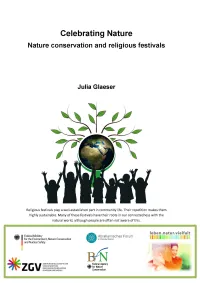Celebrating Nature – Nature conservation and religious festivals 2021


Description
The booklet Celebrating Nature has been produced as part of the project ‘Religions for biodiversity’, which links religious communities and nature conservationists in Germany in a dialogue process coordinated by the Abra-hamic Forum in Germany. The aim is to communicate the value of nature, nature conservation and biodiversity and to give members of religious communities an opportunity to realise this value locally, nationally and in-ternationally. The booklet sets out to highlight the various religious festivals that connect with nature and that can be used to address its conservation. This approach enables people of other religions or of no religious affiliation to learn about these festivals. In addition, it reminds religious communities themselves of the links between their faith and the natural world and of the associated need to protect nature and the environment. When members of different religions celebrate festivals together, they learn from and about each other and new contacts and even friendships may be formed and con-tribute to the conservation of nature.
The publication profiles festivals from Alevism, the Bahá’i religion, Bud-dhism, Christianity, Hinduism, Islam, Judaism and Yezidism that relate to the appreciation and safeguarding of nature. Each description includes the name of the festival and details of when it is celebrated and how it is origi-nated. The rituals and practices associated with the festival in our own time are explored, together with the potential significance of the festival for na-ture conservation. Similarities with the festivals and rituals of other religions are also highlighted.